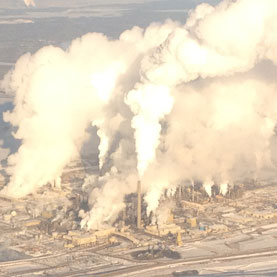|

"I have no issue bringing my family here, I'm just as happy here
as anywhere," says Baragar, of the Wood Buffalo Environmental Association (WBEA),
an outfit funded by the oil and gas industry to monitor air pollution from their operations in Alberta's tar sands. "I don't
see any difference."
That is a testimony to industry efforts to clean up air pollution—or, as Scott Wenger, manager
of government relations for tar sands producer Suncor says of the steam and smaller amounts of other gases billowing from his company's smokestacks and joining the cloud layer: "We scrub it pretty good."
It is also an illustration of the ubiquity of bad air,
which has many causes, from forest fires to the off-gassing of tar sands mini-refineries like Suncor's, a record preserved in canisters of air and bags of lichen and moss that date back almost to Wood Buffalo's
founding in 1997. The shy, self-effacing Baragar with his soul patch and salt-and-pepper hair, sees sulfur pollution from
the northern U.S.—and even China—drift
all the way to his remote air monitoring stations.
But what goes up must eventually come down—and the pollutants
put out by refinery smokestacks, the tailpipes of the world's largest trucks and other tar sands industrial equipment closer to home is accumulating in the water.
It's in the water
The Athabasca River has carved bluffs in the Alberta landscape on
its way north. But these natural bluffs are more than matched by the man-made sand dikes built to hold back many lakes-worth of tailings, the muck-laden
water leftover after tar sands mining and treatment. Leaks of this muck, which contains a toxic stew of hydrocarbon residue,
have always been a concern.
"There is a risk if there was a leak into the river, it would be disastrous," notes chemical
engineer Murray Gray, scientific director of the Center for Oil Sands Innovation at the University of Alberta. But "any release
of tailings are disastrous for watersheds anywhere in the world."
The difference may be the scale. Such waste lakes now cover 176 square kilometers, holding more than 830 million cubic meters of residue with another roughly 250 million
liters of the muck produced every day. Wells are drilled all along the man-made bluffs to detect ongoing seepage and, if detected,
to pump out the contaminated water. "A small amount will get past that," admits Randall Barrett, northern region director
for Alberta's Environment and Sustainable Resource Development (ESRD) agency, although at a very slow rate, he adds. Given that the
river also naturally erodes such tar sands deposits and carries away the bitumen, it remains difficult to determine whether
the hydrocarbons in the river water came from natural floods or human mining efforts, despite abundant anecdotal reports of
deformed fish and rare cancers in downstream communities such as Fort Chipewyan. After all, by one scientific estimate the
Athabasca River deposits roughly an Exxon Valdez's worth
of oil every four years or so along its more than 1,200-long kilometer journey. But that's only when scientists attempt to
measure the pollution already in the river water.
By measuring the toxic heavy metal pollution in snow, scientists have suggested that contamination exceeds background levels as much as 120-fold and can be detected
as far as 85 kilometers from industrial sites. "It's hard to fingerprint because air pollution goes up, falls out as snow,
snow melts, ends up in the river, is then detected—and it's hard to decide whether that's from oil sands or China,"
argues Andy Ridge, director of the water policy branch at ESRD. "The goal is to moderate the impact of development, but it
will have an impact."
But by taking sediment cores of naturally isolated
small, shallow lakes north of here, a team of Canadian scientists, including government scientists from Environment Canada,
have shown that hydrocarbon pollution increased from 1967, when the first tar sands mine opened, through 2010. The greatest
contamination was found in those pothole lakes directly downwind of oil sands mining operations. In other
words, the tar sands impact wasn't flowing down the river so much as falling from the skies into the river and other local
waters.
As biologist Peter Hodson of Queen's University in Ontario put it in a commentary on the paper announcing the findings published online January 7 in Proceedings of the National Academy of Sciences: "Assertions
that [hydrocarbon pollution] in the [Athabasca River] watershed are entirely caused by natural erosion of bitumen are no longer
tenable."
Real impact
The levels found in the sediment cores from five
pothole lakes in some cases exceed Canadian standards for water quality to protect aquatic life and are at least twice as
high as before oil sands development began. And sediments from oil sands have been shown to be toxic to some of the fish native
to northern Alberta. At issue are so-called polycyclic aromatic hydrocarbons with names like anthracene and napthalene, among others, many of which are known to cause cancer and other health effects in animals and people.
But instead of devastating these
lakes, both algal productivity and tiny aquatic animals that graze on these blooms have thrived even as pollution has increased. This may
be because warming temperatures have helped the algae grow more abundant and the increase in food has outweighed any negative
impacts from oil sands pollution, the researchers suggest.
"While current concentrations are not known to be toxic,
by linking the rates of increase to rates of oil sands production, there is
concern that projected increases in oil sands expansion will cause toxic contaminations to be present in lake sediments in
10 years or so," says biologist David Schindler of the University of Alberta, who was not involved in the study but also works
on oil sands pollution.
Further, the paper notes that even those lakes so close to tar sands operations have much lower
levels of such toxic contamination than lakes in urban environments, which endure high levels of local coal, natural gas,
gasoline and diesel burning. Even one of the largest industrial operations on the planet pales in comparison with themundane combustion of fossil fuels on a daily basis to power modern society.
Air pollution
Baragar doesn't monitor for the kind of air pollution falling out of the sky and into these lakes at every site, and only reports "total hydrocarbons" rather than specific
ones of interest. Wood Buffalo is most focused on the kinds of pollution that have legal limits, such as sulfur dioxide. The
same problem can be found in the Regional Aquatics Monitoring Program, the water
pollution monitoring effort set up by the oil and gas industry at the same time as WBEA. "We have been doing this for more
than 40 years and we have yet to figure out a credible monitoring system," notes Jennifer Grant of the Pembina Institute,
a Canada-based environmental group. For example, a project currently under consideration—Shell's Jackpine tar sands
mine expansion—would have air pollution levels three times higher than Alberta's regulatory standards for nitrogen oxides,
according to Shell's own analysis.
Regardless of the air and water pollution getting out and about into northern Alberta
and beyond, there remains the large problem of what to do with all those tailings lakes, which will
take decades if not longer to settle enough to allow cleanup. New technologies may help speed up that process, such as using
plastics or coal ash to help solidify the muck or even spinning it in centrifuges to wring out the water. But, even after such reclamation,
pollution will remain a concern. It remains to be seen if rainfall falling on the reclaimed tailings pond known as Suncor Pond 1 will leach out buried contaminants or not. And then there's that highway
here, which has gotten so busy that it is continually undergoing construction. Traffic in this town of roughly 60,000 people
is as stop-and-go as cross-town traffic in Manhattan. Baragar's in-town monitor had to be moved away from the highway to get
a better sense of ambient air quality without being overwhelmed by the emissions of all those idling cars and trucks.
As
it stands, air quality in oil sands communities is considered "low health risk," and lower health risk than larger cities
such as Edmonton and Calgary. Whereas acid-rain causing emissions remain high and noxious odors are prevalent, the current
air monitoring argues that oil sands development has not had an outsized impact on air quality. And there is no sign that
contamination in water has reached levels that could directly harm humans living downstream, yet. That may change soon and
the Royal Society of Canada, among others, argues that more monitoring is needed.
"The
landscape has gotten much busier," admits Bev Yee, assistant deputy minister at Alberta's ESRD. "Alberta is very popular with
monitoring, everybody cares how Alberta monitors"—a tacit acknowledgement that the actions taken here have a local,
national and even international impact.
^^^^^^^^^^^^^^^^^^^^^^^^^^^^^^^^^^^^^^^^^^^^^^^^^^^^^^^^^^
Wikipedia: http://en.wikipedia.org/wiki/Shale_oil
Global technically recoverable oil shale reserves have recently been estimated at about 2.8 to 3.3
trillion barrels (450×109 to 520×109 m3)
of shale oil, with the largest reserves in the United States, which is thought to have 1.5–2.6 trillion barrels (240×109–410×109 m3).[10][35][38][39]Worldwide production of shale oil was estimated at 11,600 barrels per day (1,840 m3/d) in 2002. The
leading producers were Estonia (5,500 barrels per day (870 m3/d)), Brazil (3,100 barrels per day (490 m3/d)),
and China (2,000 barrels per day (320 m3/d)).[40] In 2008, China led production with 470 million liters (ML), followed by Estonia (445 ML) and Brazil (250 ML).[41]
The production
of shale oil has been hindered because of technical difficulties and costs.[42] In March 2011, the United States Bureau of Land Management called into question proposals in the U.S. for commercial operations, stating
that "There are no economically viable ways yet known to extract and process oil shale for commercial purposes."[43]
|
